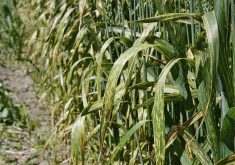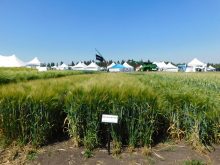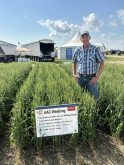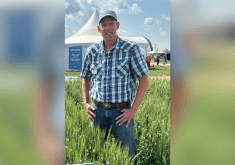What do Prairie farmers want when it comes to cereal breeding?
That’s the question being posed by the Western Grains Research Foundation, the farmer-run conduit for most of western grain farmers’ investment in agricultural research.
“Breeding is a long-term process,” Garth Patterson, the foundation’s executive director, said at Winter Cereals Manitoba’s recent annual meeting.
“You have to look 10 or 15 years out. You have to start planning for that now if there are new models out there that farmers want to be involved in.”
Read Also

Hail research hopes to benefit potato growers
Alberta research scientist measures hail storm and heat dome affects on potato crops
The foundation has given federal government breeders and researchers $82 million in funding — most of which comes from wheat and barley checkoffs — since 1995. But Agriculture and Agri-Food Canada has said it plans to focus on upstream varietal development, instead of releasing market-ready cultivars.
“They haven’t given us dates, but they have said that to give more space to private industry,” Patterson said.
Although the foundation is committed to funding public research until at least 2020, producers need to decide soon on its future direction — or even if it needs to continue, Patterson said in an interview.
“What’s important for producer groups during the next one to two years is to make some decisions and start implementing plans,” he said. “We can’t wait until 2020. There has got to be a planned transition.”
From the Manitoba Co-operator website:
Canola growers debate UPOV ’91
The biggest thing for farmers growing cereals is the bottom line, and that’s got to improve, said Kent Erickson, who farms near Irma and is chair of the Alberta Wheat Commission.
“What makes money for farmers is more yield,” he said. “Incremental yields is obviously the No. 1 genetic increase we’re looking for.”
There should be a continued focus on improving hard red spring varieties, but better Canada Prairie Spring varieties are also needed,he said.
“There’s a lot of appetite for CPS in the world,” he said. “It’s not as high quality as hard red spring, but our CPS could really fit a market. With a little quality and better yield, we could probably get good profitability for our producers.”
UPOV ’91 supported
The wheat commission supports UPOV ’91 — a stronger form of plant breeders’ rights that Ottawa says will encourage more private-sector plant breeding. It’s looked at the Australian model, where farmer organizations and private companies have formed joint ventures in cereal breeding. While it “isn’t a perfect model,” Australia offers lessons for Canada, said Erickson.

“The Australians have an end-point royalty system,” he said. “That’s the starting point and the principle that we want to start from… I think that is going to bring money back to the table.”
Patterson said his organization wants to do what’s best for farmers, even if that means the foundation plays a smaller role in research.
“We’re asking the big questions like, ‘What does success look like?’” Patterson said. “Is it important to continue to have public varieties, but do you also want to attract the investments that private industry is making and commercializing in other parts of the world so you have choices?”
The Alberta Wheat Commission favours a “three-P approach” in which producers, public bodies and private companies form partnerships, said Erickson.
But at the end of the day, success will only come if there’s a bigger investment in cereal breeding, he said.
“The government has been putting money in, producers have been putting money in, but really, it hasn’t been enough to get us up to speed with everybody else in the world,” he said.
“The dollars that the Australians and the Americans are putting into plant breeding, compared to what we are doing, is kind of a little bit embarrassing.”















